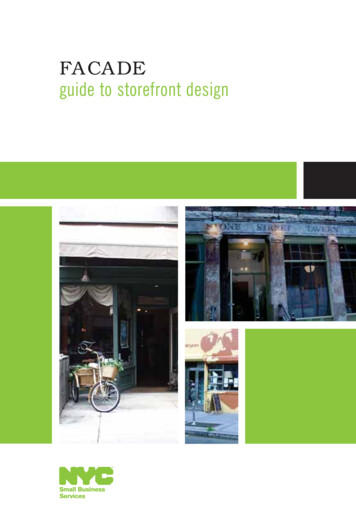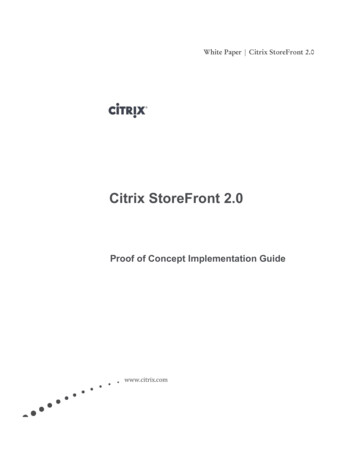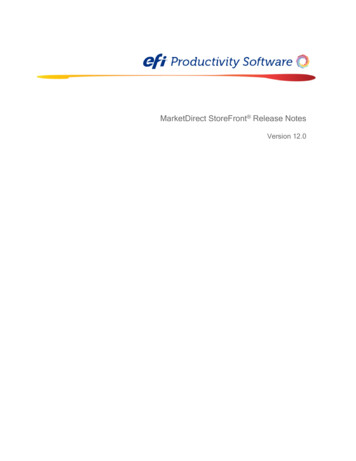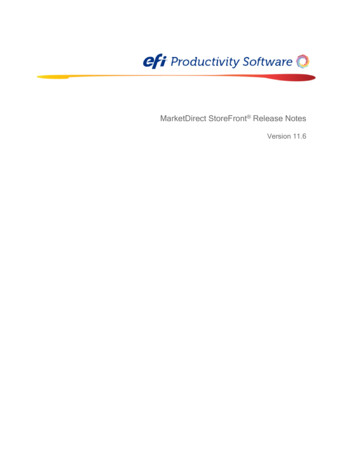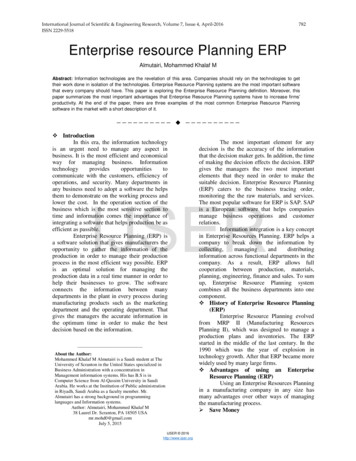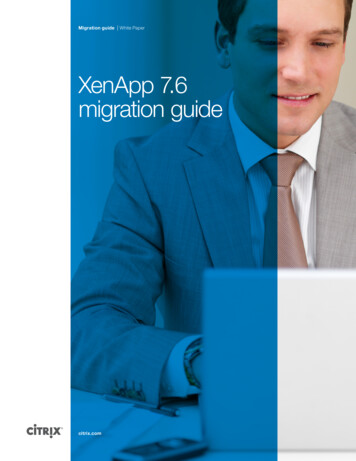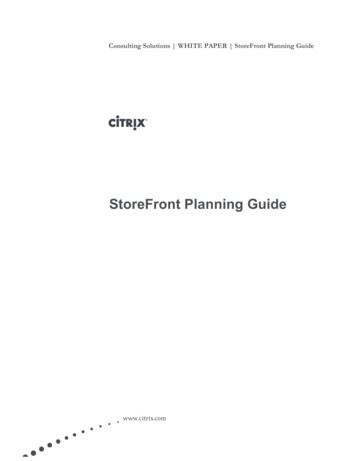
Transcription
Consulting Solutions WHITE PAPER StoreFront Planning GuideStoreFront Planning Guidewww.citrix.com
ContentsOverview . 3StoreFront Functionality & Architecture . 4User Logon Workflow . 7Guidelines . 8Web Interface or StoreFront . 8High Availability . 9Security – Inbound Traffic . 9Security – Backend Traffic . 10Delivery Controllers . 10Beacons. 11Auto Provisioned Apps (Keywords) . 11Scalability (preliminary) .12Planning .13Scenario 1 – 500 Users . 13Scenario 2 – 5,000 Users. 14Scenario 3 – 10,000 Users . 15Scenario 4 – 10,000 Users with Split Sites and Dedicated Home Datacenters . 17Page 2
OverviewCitrix StoreFront, which is the successor to Citrix Web Interface, authenticates users to XenDesktop sites,XenApp farms, App Controller (SaaS Apps), and VDI-in-a-Box enumerating and aggregating availabledesktops and applications into stores that users access through Citrix Receiver for Android, iOS, Linux,Windows, Win8/RT or Receiver for Web sites. StoreFront is an integral component of XenDesktop 7 butcan be used with XenApp and XenDesktop 5.5 and up deployments. It has been built on a modern, moreflexible and powerful framework than Web Interface that enables StoreFront to provide next generationfeatures, such as: Unified StoreFront for XenApp and XenDesktop resources that can also deliver SaaS & NativeMobile applications (through App Controller). Simplified Account Provisioning, which enables users to connect to assigned desktops andapplications by simply entering their email or server address, or by opening a Provisioning File inReceiver. Access from any Receiver with a consistent user experience, including automatic fallback toReceiver for HTML5 on Receiver for Web sites if a native client isn’t available locally and can’t beinstalled. Synchronization of resource subscriptions across all platforms and devices (Follow-me Apps &Data). Cross-farm aggregation and de-duplication, that aggregates and delivers a unique set ofapplications from multiple farms across different sites. Farm-Based Optimal HDX Connection Routing, which enables the use of the nearest NetScalerGateway for HDX traffic routing independent of the NetScaler Gateway used for initialauthentication.This planning guide provides details about the StoreFront architecture and key design decisions fortypical deployments.Page 3
StoreFront Functionality & ArchitectureThe following diagram depicts a typical StoreFront infrastructure for environments without XenMobile:Please refer to CTX138635 - Citrix Reference Architecture for XenMobile 8.5 for further information about XenMobile deployments.
StoreFront consists of the following components: Authentication service: This service, which is an integral part of StoreFront,authenticates users to XenDesktop sites, XenApp farms, and App Controller (for SaaSapps). The authentication service ensures that users only need to log on toStoreFront/Receiver once. Store: The store retrieves user credentials from the authentication service to authenticateusers to the components providing the resources. The store also enumerates andaggregates the resources currently available from XenDesktop sites, XenApp farms, andApp Controller (SaaS Apps). Users access the store through Citrix Receiver or a Receiverfor Web site. Application Subscription Store (Data Store): This store saves and indexes theapplication or desktop subscriptions of the users on a per-StoreFront Store basis. Incontrast to older versions of StoreFront, where an external Microsoft SQL database wasrequired, the new Application Subscription Store uses the built-in Microsoft WindowsExtensible Storage Engine to store details of users’ app subscriptions locally on StoreFrontservers. When joining a StoreFront server to a Server Group the replication of databetween all members is configured automatically. Receiver for Web site: This site enables users to access stores through a webpage.Furthermore, this site can verify the version of Receiver installed locally on the endpointand guide the user through an upgrade or installation procedure if required. In scenarioswhere Receiver cannot be locally Receiver for HTML5 can be enabled for the Receiver forWeb sites so that users can access resources directly within HTML5-compatible webbrowsers. Desktop Appliance site: Desktop Appliance sites provide users of non-domain desktopswith an experience similar to that of users with domain-joined desktops. The web browserson desktop appliances are configured to start in full-screen mode displaying the logonscreen for a Desktop Appliance site. When a user logs on to a site, by default, the firstdesktop (in alphabetical order) available to the user in the store for which the site isconfigured starts automatically. Desktop Appliance sites are only created by default whenStoreFront is installed and configured as part of a XenDesktop installation. XenApp Services site: Users with older Citrix clients that cannot be upgraded can accessstores by configuring their clients with the XenApp Services URL for a store. This site canalso be used from domain-joined desktop appliances and repurposed PCs running theCitrix Desktop Lock. NetScaler Gateway: Citrix NetScaler Gateway is a physical or virtual appliance, whichprovides secure remote access to internal resources. The appliance is typically locatedwithin the DMZ and exposed to the Internet. When a user connects to NetScaler Gatewaythey will need to authenticate before any access to internal resources is granted. Theaccess can be controlled by the admin by means of granular application-level policies andaction controls.
Users connect to StoreFront using three different methods: Receiver for Web: This component allows users to access their stores from a webbrowser. Desktops and applications are launched using the locally installed Receiver orReceiver for HTML5 for clientless access. Native Receiver: To take full advantage of the features StoreFront has to offer, usersshould connect into the Citrix environment using Citrix Receiver on their desktop or mobiledevice. Citrix Receiver is available for Android, iOS, Mac, Window 8/RT, Windows Phone,and soon Linux. XenApp Services Site (PNAgent): By default, StoreFront creates a XenApp Services siteto provide access from legacy devices to the XenApp and XenDesktop resources availablein a store. Even though XenApp and XenDesktop resources can be accessed through thePNAgent site, resources from App Controller are not visible. This site enables access froma variety of thin clients, Receiver for Enterprise for specific use cases such as as aseamless desktop experience, Fast Connect, and Desktop Lock for repurposed PCs.Page 6
User Logon WorkflowThe user logon workflow in StoreFront is different to Web Interface, as detailed in the followingtable:StepWeb InterfaceStoreFront1User enters username and password. This issent to the Web Interface server.User enters username and password. This issent to the StoreFront server.2The authentication service of StoreFrontfetches the user credentials and validatesthem with a domain controller. StoreFrontservers must reside either within the ActiveDirectory domain containing the user accountsor within a domain that has a trust relationshipwith the user accounts domain. All theStoreFront servers in a group must residewithin the same domain.3StoreFront checks the data store for existinguser subscriptions and stores them in memory.4Web Interface forwards the user credentials aspart of a XML query to XenApp or XenDesktopsequentially. In this case, the credentials aresent to the XenDesktop Controller which is thesole resource configured.StoreFront forwards the user credentials aspart of a XML query to the backend systems,such as XenApp, XenDesktop, App Controlleror VDI-in-a-Box sequentially. In this case thecredentials are sent to the XenDesktopController which is the sole resourceconfigured.5The XenDesktop Controller validates the user credentials with a domain controller.6After a successful validation the XenDesktop Controller checks which resources have beenpublished to this user within its database.7The XenDesktop Controller sends an XML response to Web Interface / StoreFront whichcontains all resources available for the user from the XenDesktop site.8Web Interface displays the availableresources.EndNow the user can start a resource.StoreFront sends the list of available resourcesincluding the existing subscriptions to the CitrixReceiver installed locally or displays them inReceiver for Web.Table 1: User Logon WorkflowsPage 7
GuidelinesStoreFront plays a critical role in the user authentication process as well as resource enumeration andaggregation of multiple providers. Therefore, designing a StoreFront infrastructure is a vital aspect of anoverall Citrix design project.Within this section critical design decisions will be discussed and recommendations will be provided.Web Interface or StoreFrontAs outlined earlier Web Interface and StoreFront are two different solutions, whose feature setsoverlap in many areas, but also offer a variety of distinct features. Therefore it is very important fororganizations to review the capabilities of each product against their requirements. In general, it isstrongly recommended to build new solutions based on StoreFront, since new features will not beadded to Web Interface and end of life has been announced for Web Interface. Furthermore it isimportant to understand that Web Interface does not support XenDesktop 7 or later. Details onWeb Interface lifecycle milestones are available from the Citrix website – Lifecycle Milestones.While StoreFront goes beyond Web Interface in many areas, StoreFront 2.0 does not support allfeatures of Web Interface. The following tables outlines the Web Interface features that are notcurrently available in StoreFront:AreaFeatureDeployment OptionsWeb Interface on NetScaler (StoreFront is deployable as an applicationbehind NetScaler but runs on separate servers)AuthenticationDelegated Kerberos AuthenticationActive Directory Federation Services (ADFS) 1.0 integrationAccount self-service (SSPR) (reset/unlock with security questions)Smart card authentication via browser (Native Receivers required)Domain pass through authentication via browser (Native Receiver forWindows required)Support for Novell NDSAnonymous authenticationOtherMessaging (user notifications)Settings per location (IP Subnet)Client proxy settings configurationOffline Apps (Users cannot access offline applications or App-Vsequences through Receiver for Web sites. Native Receiver isrequired)Compact/Low graphics Mode and embeddingTable 2: Web Interface features currently not supported by StoreFront 2.0Page 8
High AvailabilityIf the server hosting StoreFront or the respective web service is unavailable, users will not be ableto launch new virtual desktops, published applications or manage their subscriptions. Therefore atleast two StoreFront servers should be deployed to prevent this component from becoming a singlepoint of failure. An intelligent load balancing appliance (e.g. Citrix NetScaler), which is capable ofverifying the availability of the StoreFront service, should be used to load balance users acrossmultiple StoreFront servers. Other less sophisticated load balancing mechanisms, such asWindows NLB, can perform very basic availability checks only (i.e. server up / down) but cannotdetermine the status of individual services. This could result in users being forwarded to StoreFrontservers that cannot process new requests (e.g. server up but web service down).Recommendation: At least two StoreFront servers should be deployed for redundancy reasonsand Citrix NetScaler or another intelligent load balancing solution should be used for load balancingand fault tolerance. To simplify management of the StoreFront infrastructure, both servers shouldbe member of the same StoreFront Server Goup.Security – Inbound TrafficCommunications from the web browser or Receiver and StoreFront server include user credentials,resource sets, and session initialization files. This traffic is typically routed over networks outsidethe datacenter boundaries or on completely untrusted connections (such as the Internet).Therefore Citrix strongly recommends that this traffic is encrypted using SSL.Note: By default, Citrix Receiver requires SSL to connect to StoreFront. This means email-basedaccount discovery or the manual configuration of a StoreFront store in Receiver will not workunless a valid and trusted SSL certificate has been implemented on the StoreFront server and/orthe respective external load balancer. However, workarounds exist for environments in which anSSL certificate cannot be implemented.Windows1. Navigate to HKEY LOCAL MACHINE\SOFTWARE\Citrix\AuthManager (for 64-bitmachines, navigate toHKEY LOCAL MACHINE\SOFTWARE\Wow6432Node\Citrix\AuthManager)2. Create a new String value called ConnectionSecurityMode.3. Set the value to Any.4. Navigate to HKEY LOCAL MACHINE\SOFTWARE\Citrix\Dazzle (for 64-bit machines,navigate to HKEY LOCAL MACHINE\SOFTWARE\Wow6432Node\Citrix\Dazzle)5. Modify the String value called AllowAddStore to A.Please refer to eDocs – Configure and install Receiver for further information.Page 9
iOS1. Add a new Store using the “New Accounts” wizard.2. Change to manual setup.3. Enable the “Ignore certificate warnings” setting.Recommendation: Implement trusted and valid server certificates on all StoreFront servers andexternal load balancers to enable SSL communication between Receiver and StoreFront.Security – Backend TrafficUser credentials are sent between StoreFront and the XenApp Controllers, XenDesktop Controllersand the App Controller virtual appliance. For example, in a typical session with a XenDesktopController, the StoreFront server passes user credentials to the Citrix XML Service for userauthentication and the Citrix XML Service returns resource set information. A TCP/IP connectionand the Citrix XML protocol is used to pass the information between the StoreFront server and theXenDesktop site. The XML protocol uses clear text to exchange all data, with the exception ofpasswords, which are transmitted using obfuscation.Recommendation: For Citrix environments with high security requirements, encrypt StoreFront toXenApp, XenDesktop and App Controller communications. For further guidance on how to encryptthis traffic, please refer to eDocs – Use the SSL Relay (XenApp only). CTX130213 - How to Configure SSL on XenDesktop 5 Controller to Secure XML Traffic(XenDesktop only). eDocs – Use SSL on XenDesktop 7 Controllers (XenDesktop only).Please refer to eDocs – Secure your StoreFront environment for further informationDelivery ControllersTo provide users with desktops and applications, StoreFront must be configured with the IPaddress or DNS name of at least one Controller in each XenDesktop site and/or XenApp farm. Forfault tolerance, multiple Controllers should be entered for each site and/or farm specified.StoreFront will automatically failover to the second server in the list in case the first serverbecomes unavailable (active/passive). For large infrastructures or environments with a high logonload an active distribution of the user load (active/active) is recommended. This can be achieved bymeans of an industry proven load balancer with built-in XML monitors and session persistency,such as Citrix NetScaler.Recommendation: At least two Controllers should be specified per XenApp farm / XenDesktopsite.Recommendation: For large environments, active/active load balancing of the delivery controllersis recommended.Page 10
BeaconsCitrix Receiver uses beacon points (web sites) to identify whether a user is connected to an internalor external network. Internal users are connected directly to resources while external users areconnected via Citrix NetScaler Gateway. Citrix Receiver continuously monitors the status ofnetwork connections (e.g. link up / link down or change of the default gateway). When a statuschange is detected, Citrix Receiver will first check that the internal beacon points can be accessedbefore moving on to check the accessibility of external beacon points. StoreFront provides CitrixReceiver with the http(s) addresses of the beacon points during the initial connection process andprovides updates as necessary.Recommendation: Configure as least two highly available external beacons that can be resolvedfrom public networks so that Citrix Receiver can determine whether users are located behind anInternet paywall, such as in a hotel or Internet café.It is strongly recommended that highly available websites are specified as beacons.Auto Provisioned Apps (Keywords)StoreFront displays applications differently to Web Interface. Instead of having all accessibleapplications appear on the home screen, first time users are invited to choose (subscribe) to theapplications they want to regularly use after they logon. Before a user can launch an application,they must first choose which applications should be placed on their home screen. This approach,deemed “Self-Service” apps, allows users to restrict the applications that they see on their homescreen to the ones that they use on a regular basis. The applications chosen by every user foreach store are recorded by the subscription store service so that they can be displayed on theReceiver home screen from any device that the user connects from (Follow me Apps).To avoid users from having a blank screen when they first logon, it is recommended thatadministrators automatically subscribe users to a few core applications. To do this,add KEYWORDS:Auto to the application or desktop description in XenApp or XenDesktop.Another option that can be used to organize applications is KEYWORDS:Featured. Unlike theAuto keyword which places certain apps on the home screen, the Featured keyword only placesapps in the Featured category (as shown below).Page 11
The app will also appear in another category if a Client Application folder has been specified.In addition the string KEYWORDS:prefer "application" can be used to specify that the locallyinstalled version of an application should be used in preference to the equivalent delivered instanceif both are available.For further information please refer to eDocs – Optimize the user experience.Scalability (preliminary)The number of Citrix Receiver users supported by a single StoreFront server depends on the hardwarespecifications and on the level of user activity. At the current point in time, scalability testing forStoreFront 2.0 has not been completed. Early testing results indicate that, a single StoreFront 2.0 serverwith twin 2 GHz quad-core CPUs and 8 GB RAM supports up to 25,000 user connections per hour in alight usage scenario (users log on, enumerate their resources, and access existing subscribed resources)or up to 6000 user connections per hour in an intensive usage scenario (users log on, enumerate theirresources, and then subscribe and unsubscribe to a resource.)For the optimum user experience, Citrix recommends that not more than 10 XenDesktop, XenApp, AppController, and VDI-in-a-Box deployments are aggregated in a single store.Page 12
PlanningWhen choosing the optimal StoreFront architecture, it is important to understand the configurationsdiscussed within this document and the requirements of the respective infrastructure. This sectionoutlines three sample customer scenarios, in which we’ll follow the topics discussed earlier opting for thesimplest and best performing solution.Scenario 1 – 500 UsersIn this scenario 500 users should be supported. The users logon to StoreFront in the morning overa period of 2 hours and connect to their virtual desktop. Users typically they keep their sessionsopen all-day and occasionally access StoreFront after the initial login.The load on the StoreFront servers in this scenario can be considered very light. Therefore twoStoreFront servers have been chosen for redundancy reasons only. Both StoreFront servers areequipped with 2 CPUs and 2GB of RAM to allow for future growth without requiring changes to theaccess infrastructure. A pair of NetScaler appliances provide load balancing, SSL offloading andavailability monitoring for the StoreFront servers. The XenDesktop Controllers are configured infailover order (active/passive) within StoreFront for simplicity reasons. An active/active loadbalancing of the XenDesktop Controllers is not required due to the small number of users.Page 13
Scenario 2 – 5,000 UsersIn this scenario, 5,000 users should be supported. As opposed to scenario 1, the users logon toStoreFront in the morning over a very short period of time. Furthermore, users tend to disconnectand reconnect to their desktops multiple times a day.Due to the high logon load in the morning, three StoreFront servers need to be implemented. Allthree StoreFront servers are equipped with 2 CPUs and 4GB of RAM to ensure sufficient capacity.A pair of NetScaler appliances provide load balancing, SSL offloading and availability monitoringfor the StoreFront servers. Furthermore, these appliances are leveraged to load balance the XMLrequests sent from the StoreFront servers to the XenDesktop Controllers. This ensures an evendistribution of the load among the XenDesktop Controllers and avoids a potential bottleneck.StoreFront is configured to connect to a NetScaler vServer rather than the XenDesktop Controllersdirectly.Page 14
Scenario 3 – 10,000 UsersIn this scenario 10,000 users should be supported. Similar to scenario 2, users logon to StoreFrontin the morning over a very short period of time and typically disconnect and reconnect to theirdesktops multiple times a day. As opposed to scenario 1 and 2 the infrastructure needs to bedistributed across two datacenters for disaster recovery reasons. The environment should provide100% tolerance to a full datacenter outage.To cope with the high logon load in the morning and the constant load during the day threeStoreFront servers with 4CPUs and 4GB of RAM are required. Alternatively, two servers with8CPUs and 8GB of RAM could be implemented. However, to minimize the impact from a singleserver outage and to have more management and maintenance flexibility a three-server solution isrecommended. Because of the 100% tolerance requirement, the same number of StoreFrontservers should be implemented in each datacenter.Users can access the environment by means of the FQDN example.mycompany.lab. The incominguser requests are distributed by means of Global Server Load Balancing (GSLB). This means theNetScaler HA pairs located in both of the datacenters are configured as authoritative DNS serversfor the aforementioned FQDN. When a user initiates a connection to the example.mycompany.labFQDN, one of the NetScaler HA pairs (selected randomly) will determine which datacenter is bestsuited to serve the request. This decision can be based on proximity, home IP subnet or similarPage 15
properties of the user. Session persistence is achieved using a client side cookie automatically setby NetScaler.Since a user can be forwarded to both datacenters, it is required to synchronize the applicationsubscriptions. This can be achieved be means of PowerShell Commandlets as outlined in eDocs To configure subscription synchronization.In addition, the NetScaler appliances within each datacenter also provide load balancing, SSLoffloading and availability monitoring for the StoreFront servers. These appliances are alsoleveraged to load balance the XML requests sent from the StoreFront servers to the XenDesktopControllers. This ensures an even distribution of load amongst the XenDesktop Controllers andavoids a potential bottleneck. StoreFront needs be configured to connect to the NetScaler vServersin both datacenters rather than the XenDesktop Controllers directly.Page 16
Scenario 4 – 10,000 Users with Split Sites and Dedicated HomeDatacentersThis scenario is equal to scenario 3 except for the fact that the XenDesktop sites have been splitinto two sites per datacenter to minimize the impact of a XenDesktop site outage. In addition, eachdatacenter is configured as a home datacenter for 50% of the users. Each user’s virtual desktop,user profile, home directory and all user related data is located in their home datacenter. In case ofa datacenter outage affected users are redirected to the second datacenter until normal operationscan be restored.In order to meet the aforementioned load balancing and failover requirements, the new StoreFrontUser Mapping and DR features need to be configured. For this scenario two user groups will becreated in Active Directory (Datacenter-A-Users and Datacenter-B-Users). For the Datacenter-AUsers user group, an Aggregation Group consisting of XenDesktop Sites 1 and 2 will be createdand configured for load balancing. In addition XenDesktop Site 3 and 4 will be configured forbackup only and vice-versa for Datacenter-B-Users. In order to ensure the StoreFront instances inboth datacenters behave equally the configuration has to be replicated. When a member of theDatacenter-A-Users user group logs on to StoreFront, the account credentials submitted will bevalidated and the user is authenticated. StoreFront then determines the user group membershipsand verifies if the user already has a session in any of the XenDesktop sites. If that is not the caseand the user cannot be reconnected or session sharing cannot be used a new user session isestablished. In case none of the XenDesktop sites in datacenter A are available, the user will bePage 17
redirected to XenDesktop Site 3 or 4. For further information in regards to StoreFront User Mappingand DR, please refer to eDocs - StoreFront high availability and multi-site configuration.Page 18
Product vision HistoryRevision1.01.11.22.0Change DescriptionInitial DocumentUpdate based on feedbackUpdate based on feedbackfrom Richard EilenbergerUpdating based on the newfeatures of StoreFront 2.0Updated ByThomas BergerDateJanuary 22, 2013With input from: Andy Baker – Architect Saul Romero – Senior Software Eng Roger LaMarca - Senior Consultant Matthew Brooks – Architect Ankur Shah – Prn Product Manager David Coleman - Director Daniel Feller – Lead ArchitectThomas BergerThomas BergerFebruary 12, 2013March 12, 2013Thomas BergerAugust 23, 2013About CitrixCitrix Systems, Inc. (NASDAQ:CTXS) is a leading provider of virtual computing solutions that helpcompanies deliver IT as an on-demand service. Founded in 1989, Citrix combines virtualization,networking, and cloud computing technologies into a full portfolio of products that enable virtualworkstyles for users and virtual datacenters for IT. More than 230,000 organizations worldwide relyon Citrix to help them build simpler and more cost-effective IT environments. Citrix partners withover 10,000 companies in more than 100 countries. Annual revenue in 2011 was 2.20 billion. 2012 Citrix Systems, Inc. All rights reserved. Citrix , Access GatewayTM, Branch RepeaterTM,Citrix RepeaterTM, HDXTM, XenServerTM, XenAppTM, XenDesktopTM and Citrix Delivery CenterTMare trademarks of Citrix Systems, Inc. and/or one or more of its subsidiaries, and may be registeredin the United States Patent and Trademark Office and in other countries. All other trademarks andregistered trademarks are property of their respective owners.Page 19
Page 3 Overview Citrix StoreFront, which is the successor to Citrix Web Interface, authenticates users to XenDesktop sites, XenApp farms, App Controller (SaaS Apps
